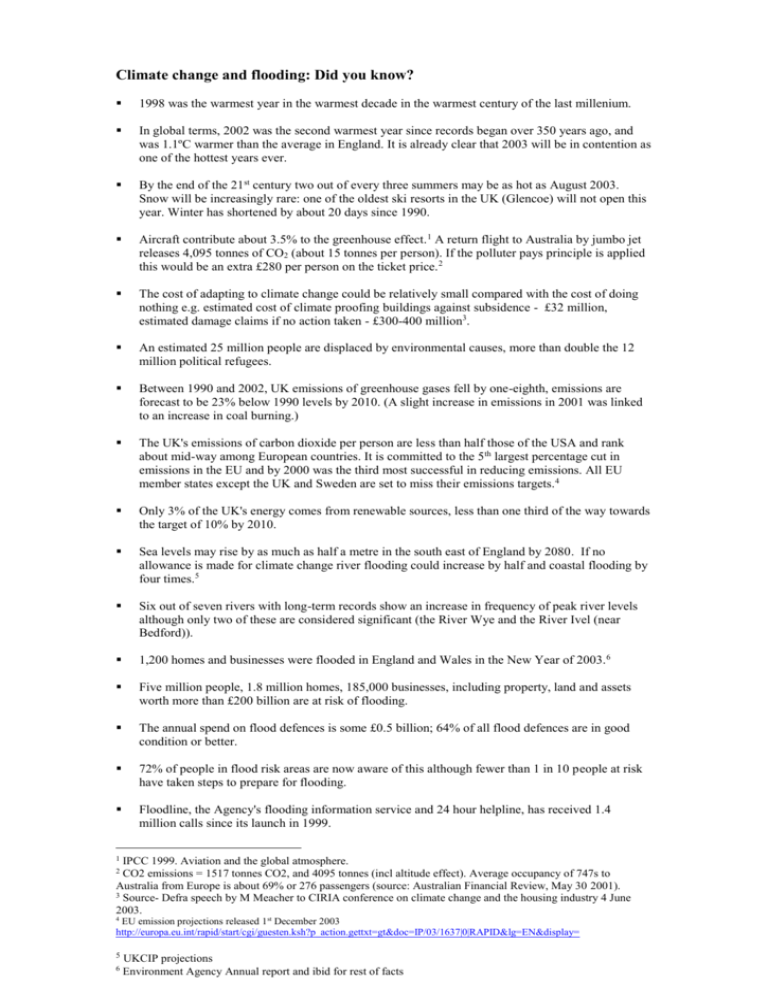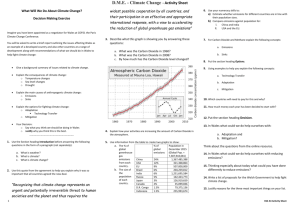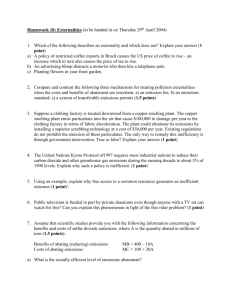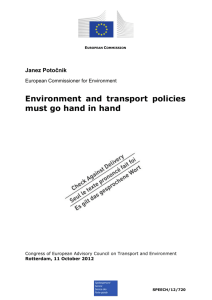Climate change and flooding: Did you know
advertisement

Climate change and flooding: Did you know? 1998 was the warmest year in the warmest decade in the warmest century of the last millenium. In global terms, 2002 was the second warmest year since records began over 350 years ago, and was 1.1ºC warmer than the average in England. It is already clear that 2003 will be in contention as one of the hottest years ever. By the end of the 21st century two out of every three summers may be as hot as August 2003. Snow will be increasingly rare: one of the oldest ski resorts in the UK (Glencoe) will not open this year. Winter has shortened by about 20 days since 1990. Aircraft contribute about 3.5% to the greenhouse effect. 1 A return flight to Australia by jumbo jet releases 4,095 tonnes of CO2 (about 15 tonnes per person). If the polluter pays principle is applied this would be an extra £280 per person on the ticket price. 2 The cost of adapting to climate change could be relatively small compared with the cost of doing nothing e.g. estimated cost of climate proofing buildings against subsidence - £32 million, estimated damage claims if no action taken - £300-400 million3. An estimated 25 million people are displaced by environmental causes, more than double the 12 million political refugees. Between 1990 and 2002, UK emissions of greenhouse gases fell by one-eighth, emissions are forecast to be 23% below 1990 levels by 2010. (A slight increase in emissions in 2001 was linked to an increase in coal burning.) The UK's emissions of carbon dioxide per person are less than half those of the USA and rank about mid-way among European countries. It is committed to the 5 th largest percentage cut in emissions in the EU and by 2000 was the third most successful in reducing emissions. All EU member states except the UK and Sweden are set to miss their emissions targets. 4 Only 3% of the UK's energy comes from renewable sources, less than one third of the way towards the target of 10% by 2010. Sea levels may rise by as much as half a metre in the south east of England by 2080. If no allowance is made for climate change river flooding could increase by half and coastal flooding by four times.5 Six out of seven rivers with long-term records show an increase in frequency of peak river levels although only two of these are considered significant (the River Wye and the River Ivel (near Bedford)). 1,200 homes and businesses were flooded in England and Wales in the New Year of 2003. 6 Five million people, 1.8 million homes, 185,000 businesses, including property, land and assets worth more than £200 billion are at risk of flooding. The annual spend on flood defences is some £0.5 billion; 64% of all flood defences are in good condition or better. 72% of people in flood risk areas are now aware of this although fewer than 1 in 10 people at risk have taken steps to prepare for flooding. Floodline, the Agency's flooding information service and 24 hour helpline, has received 1.4 million calls since its launch in 1999. 1 IPCC 1999. Aviation and the global atmosphere. CO2 emissions = 1517 tonnes CO2, and 4095 tonnes (incl altitude effect). Average occupancy of 747s to Australia from Europe is about 69% or 276 passengers (source: Australian Financial Review, May 30 2001). 3 Source- Defra speech by M Meacher to CIRIA conference on climate change and the housing industry 4 June 2003. 2 4 EU emission projections released 1st December 2003 http://europa.eu.int/rapid/start/cgi/guesten.ksh?p_action.gettxt=gt&doc=IP/03/1637|0|RAPID&lg=EN&display= 5 6 UKCIP projections Environment Agency Annual report and ibid for rest of facts Air quality: Did you know? Compared with the 1960s there are now four times more cars, doing four times the mileage, but 20 modern cars produce the same amount of pollution as one 1960s car. In the UK, one-fifth of fine particles, one-quarter of CO2, and 44 % of nitrogen oxides come from traffic, but this contribution is much higher in urban areas. Improvements in technology are reducing emissions from vehicles but greater car use is offsetting some of the gain. Journeys when the engine is cold pollute up to 60% more than when the engine is hot. In a 4km journey 80% of the emissions are during the first kilometre. Some people are more susceptible to air pollution than others. Vulnerable groups include the young and elderly, people with respiratory problems and asthma sufferers. About one in ten of all people who die each year may have died slightly early because of air pollution. In urban areas, days of poor air quality occur about once every two and a half weeks on average. Ten years ago the frequency was once every six days. 7 High ozone levels build up when UK emissions are mixed with polluted air masses from continental Europe. In August 2003 peak ozone concentrations in parts of England were at their highest since 1990, and in September 2003 peak levels occurred at the latest in the year since 1985.8 The UK ranks mid-way among European countries for sulphur dioxide and nitrogen oxide emissions per head9 but has achieved the fourth largest percentage reduction in sulphur dioxide and the largest reduction in nitrogen oxides (between 1990 and 1999)10. The quantity of dioxins released from Agency-regulated processes has been reduced by 93% between 1990 and 2002.11 The ozone layer has been observed to thin at certain times of the year for the past 18 years. In August 2003 the Antarctic ozone hole was about 27 million km2, covering all of the Antarctic and reaching the tip of South America and the Falkland Islands. 7 8 Agency indicator days of poor air quality2002= 20 days poor air quality, 1993, 59 days poor air quality. NETCEN 2003. Air pollution forecasting: ozone pollution episode report (August 2003). AND Air pollution forecasting: ozone pollution episode report (September 2003). www.airquality.co.uk 9 EEA Kiev report 10 EEA Signals 2002 11 Environment Agency (info from website check for relevant publication) Soil quality: Did you know? Annual soil erosion losses generally represent less than 1mm from the surface but some cultivated fields lose as much as a centimetre of soil in years of heavy rain. 12 ‘Muddy floods’ are a result of soil erosion from agricultural land. Almost all incidents occur in the months of October and November when winter cereal crops leave soils exposed to heavy rain. Such conditions on the South Downs have been associated with an average of five ‘muddy floods’ a year since 1976.13 Trout spawning beds in over half of the river reaches surveyed across southern England had high levels of fine sediments which harm the fish and other aquatic life. 14 Agricultural soil erosion is the probable cause. Agricultural soils (along with sewage effluent) are a major source of nitrate and phosphate pollution of fresh waters (see Water Quality). Since 1988 the total volume of pesticides used has decreased by one-eighth in England and Wales, but the area of land sprayed has more than doubled. The toxic loading and risks to biodiversity are not well known. Between 1979-81 and 1995 the organic matter content of agricultural topsoils fell by an average of 0.5%.15 This loss may adversely affect soil structure, resistance to erosion, biodiversity, nutrient retention and other soil functions. Soils continue to be acidified and over-enriched with nitrogen: air pollutant deposition exceeds ‘critical loads’ for acidity and for the nutrient effects of nitrogen over 80% and 95% respectively of the total broad habitat area.16 Between 1969 and 1993 the proportion of acidic soils (less than pH 6) under agricultural grassland increased from 39% to 55%.17 The Countryside Survey 2000 reported that the acidity of soils in a range of habitats had decreased between 1978 and 1998 (by up to about 0.5 pH units). 18 By mid-2003, 63 sites in England and Wales had been confirmed as formally contaminated land, of which 16 are 'special' sites where the Agency becomes the enforcing authority. Thousands more sites are potentially contaminated. 12 Department for Environment, Food and Rural Affairs, 2002. Agriculture and water: a diffuse pollution review. Defra, London, 115pp. 13 Boardman, J, 2003. Soil erosion and flooding on the eastern South Downs, southern England, 1976-2001. Transactions of the Institute of British Geographers, 28, 176-196. 14 Milan, DJ, Petts, GE and Sambrook, H, 2000. Regional variations in the sediment structure of trout streams in southern England: benchmark data for siltation assessment and restoration. Aquatic Conservation: Marine and Freshwater Ecosystems 10, 407-420 15 Ministry of Agriculture, Fisheries and Food, 2000. Towards sustainable agriculture: a pilot set of indicators. Maff, London, 72pp. 16 Hall, J, Ullyett, J, Heywood, E, Broughton, R and Fawehinmi, J, 2003. Preliminary assessment of critical load exceedance. UK National Focal Centre, Centre for Ecology and Hydrology, Monks Wood. 17 18 Department of the Environment, 1996. Indicators of sustainable development for the UK. Centre for Ecology and Hydrology and DETR, 2000. Accounting for nature: assessing habitats in the UK countryside. Water quality: Did you know? In 2002, over 94% of rivers were of very good or fair quality and 68% were good or very good. In 2003, 98.8% of bathing waters passed European minimum standards and three-quarters met the stricter guideline standards. Over half the rivers in England and Wales have high phosphate levels and nearly a third have high nitrate levels. 4 in 10 river stretches have improved in chemical water quality since 1990 and 3 in 10 have improved biologically. Most of this improvement occurred between 1990 and 1995. Water companies will have spent over £12 billion between 1990 and 2005 on cleaning up water pollution from their sewers and sewage works. If the proposed investment programme to 2010 is approved, 6,000 km of river and over 3,000 km2 of still or coastal waters would be enhanced. Businesses and households have an estimated one million or more drain misconnections that release dirty water into surface drains and contribute to poor river quality. In the marine environment populations of dog whelks were severely reduced by the masculinisation of females. Tributyltin (TBT), used as an anti-foulant in paint on ships' hulls, was found to be the chemical responsible. TBT was banned in England and Wales in 1987, and internationally from January 2003. Controls on discharges from industry resulted in a 70% reduction in UK mercury loads to the sea from 1990 to 2001. Mercury is very toxic. In the Faeroe Islands (North Atlantic) a study revealed that children born to mothers who ate mercury-contaminated whale meat had relatively low language, attention and memory scores. Groundwater provides more than 75% of public water supply in south east England and over onethird in England and Wales as a whole. In early 2003, groundwater levels were at or above the long-term average, but the long dry summer has led to drought warnings for next year as levels in some sites are low. Most of the UK’s freshwater resources are stored as groundwater. The two main aquifers, Chalk and the Permo-Triassic sandstones, hold 20 times more water than all the surface reservoirs. Nitrate levels in groundwater have been rising for the past 20 years. Nitrate standards are set for potable supplies as nitrate may affect human health and is linked to blue baby syndrome. It costs £16 million a year to remove nitrate from the public water supply 19. The UK is the 16th poorest out of 20 European countries for the proportion of groundwater sampling sites exceeding the drinking water standard for nitrate. 20 Protection zoning is vital for the sustainability of groundwater abstraction. Nitrate Vulnerable Zones cover 55% of England and 3% of Wales and aim to reduce nitrate pollution of groundwaters and rivers. On current trends in nitrate concentrations many more groundwater sources will exceed the nitrate standard by 2100. The cost of removing pesticide residues from drinking water at over £120 million each year (Pretty et al., 2001) is equivalent to the water bills of half a million households. 19 Pretty J., Brett C., Gee D., Hine R., Mason C., Morison J., Rayment M., van der Bijl G., and Dobbs T. (2001) ‘Policy Challenges and Priorities for Internalising the Externalities of Modern Agriculture’, in Journal of Environmental Planning and Management, Vol. 44 (2) pp 263-383. 20 EEA, 2003. Europe's Water: An indicator based assessment. Wildlife habitats and species: Did you know? The UK Biodiversity Action Plan has identified 45 important habitats. In 2002, 17 of these were reported as declining, 12 were improving or stable, and 16 were in an unknown state. In England, as at 2003, four in ten of SSSIs are not in a good condition. 21 The abundance of moths has fallen by 60 % since the 1930s (Rothamsted) and three-quarters of butterfly species have declined over the past 30 years. Populations of farmland birds are 45% down since 1970 but appear to have stabilised since the mid-1990s. The woodland bird index was 21% below the 1970 level in 2002, with generalist species faring well but specialists like the lesser spotted woodpecker in serious decline. 22 New development covers about 70km2 of land every year, which is equivalent to losing one in every fifty average sized gardens (or to 1.4 million average sized gardens )23. High levels of nitrogen deposition from the air are affecting the environment in over 95% of habitats, causing a decline in vegetation diversity, while 80% of habitats are affected by acidification from acid rain.24 Otters were found at 6% of sites in the late 1970s but had increased to 36% in England in 20002002.25 The numbers of eels returning to European rivers had declined by some 98% by 2001 compared with populations in the 1970s.26 Salmon numbers were below the spawning stock conservation limit in 71% of rivers in England and Wales in 2002.27 Some 30 species of lichen have recolonised urban sites in response to the clean-up of sulphur emissions from industry and coal burning. 28 21 Joint Nature Conservation Committee, 2003. UK biodiversity website. www.ukbap.org.uk. Defra 2003. A biodiversity strategy for England. Measuring progress: baseline assessment. 23 50m2 is average sized garden estimate from internet survey. 22 24 Hall, J, Ullyett, J, Heywood, E, Broughton, R and Fawehinmi, J, 2003. Preliminary assessment of critical load exceedance. UK National Focal Centre, Centre for Ecology and Hydrology, Monks Wood. 25 Environment Agency, 2003. The fourth otter survey of England: 2000 to 2002. Environment Agency, Bristol. 26 Environment Agency fisheries paper (Miran Aprahamian). 27 Environment Agency data 28 Natural History Museum 2002. Lichens - silent witnesses of air quality. www.nhm.ac.uk Use of resources and waste: Did you know? Household water use in the UK has increased from 140 litres/person/day in 1992/93 to 150 litres/person/day in 2001/02 but has been constant for the last five years. Leakage in England and Wales has reduced from 3,610 Ml/d in 1992-93 to 3,414Ml/d in 2001-02, or from 163 litres to 146 litres per property per day. Water efficiency in relation to output (GDP) improved by one-fifth in the four years to 2001/2002. Between 1990 and 2002, the UK's energy consumption increased by 7% and electricity use rose by 22%; renewable sources supplied 3% of electricity in 2002.29 We use about 40 tonnes of materials per person each year (including minerals, biomass and fossil fuels).30 One-third of our materials are imports with high transport energy costs. The UK is overall one of the most resource-efficient nations in the EU although it is slightly less efficient in the amount of material required for each unit of GDP than Germany or France. 31 Some 75 million tonnes of commercial and industrial waste were produced in 1998/99 of which 43% was reused, recovered or recycled and almost a half landfilled. Industries regulated by the Agency have reduced their waste production by over a fifth in the past five years. Of the 73 million tonnes of construction and demolition waste produced in 1998/99, only a quarter was landfilled, a reduction in recent years due to the impact of the Landfill Tax. Hazardous waste, with its greater potential to harm human health and the environment, makes up about 1% of the waste stream. The quantity fell by 3% in 2002 but it is set to increase by 50% in the next five years as more waste is legally classified as hazardous. Household waste has increased by 1.4 to 5% annually in recent years. Of the 29 million tonnes of municipal waste produced in England in 2001/02, 77% was landfilled and 13.6 % recycled or composted. The UK produces about 7 tonnes of waste per person per year, over four tonnes of which is landfilled. The UK produces the 4th highest amount of waste per head out of 22 European countries32 and has the lowest rate of recovery of municipal waste out of 11 European countries. 33 29 DTI 2003. Digest of UK energy statistics. Wuppertal Institute 2001. Total material resource flows of the UK. 31 EEA Kiev report 32 EEA Kiev report 33 EEA Kiev report 30 Your street/backyard: Did you know? Unpleasant odours from industry, sewage works, and agriculture generated 10,000 complaints to the Agency from the public in 2002.34 Local authorities in England and Wales received 305,000 complaints in 2002/03, compared with 239,000 in 2000/01. Three-quarters of the complaints are about domestic noise. 35 Changes in measured outdoor noise levels and exposure were small between 1990 and 2000, with a slight decrease in daytime noise and a slight increase at night. 36 Night satellite pictures show that light pollution in England is worse than in most other European countries, mainly due to street lights, while Wales has large areas unspoiled by lighting.37 In 2003, a record number (182) of parks and green spaces in England and Wales were given a Green Flag award, recognising their performance in several aspects including safety, cleanliness, sustainability and conservation.38 The percentage of streets with a very or fairly satisfactory level of cleanliness in 2000/01 was 63% in England.39 An Agency survey of 452 river sites in 2000 found 41 per cent of urban rivers with poor or bad aesthetic quality due to litter compared with 27 per cent of rural rivers. Serious fly-tipping increased by 20% in 2002. The most recent public attitudes survey (2001) found that: – 65% of people recycled paper, 58% recycled glass and 41% recycled cans; – half had consciously reduced their energy and water use, for example using low-energy light bulbs; – two-thirds had at some time chosen to use public transport or walk or cycle instead of using the car.40 34 Environment Agency Annual Report 2002/3 Chartered Institute for Environmental Health. www.cieh.org.uk; Defra Digest of Environmental Statistics 36 Department for Environment, Food and Rural Affairs, 2002c. We shouldn’t shut up about noise. DEFRA press release, 20 May 2002 37 Department of the Environment and Countryside Commission, 1997. Lighting in the countryside: towards good practice. The Stationery Office, London; Campaign for Dark Skies, www.dark-skies.org; House of Commons Science and Technology Committee, 2003 Light pollution and astronomy. 38 CABE Space 35 39 Audit Commission best value performance indicators. 40 Defra 2001 Public Attitudes Survey Seven ….. Seven worst cities - according to a representative list of national monitoring sites given by Defra, 2002 regional quality of life counts, the worst urban sites (most days of moderate or higher air pollution; excluding roadside sites): Redcar Blackpool Thurrock (Thames estuary) Southend-on-Sea London (includes 4 sites: Brent, N Kensington, Bexley, Eltham) Middlesbrough Norwich Five most threatened garden birds - the RSPB garden birds survey shows the 20 birds most commonly seen in gardens; of these only 5 have been identified as of concern because of population decline: song thrush house sparrow starling blackbird dunnock (hedge sparrow). Seven fly-tipping hotspots - based on Environment Agency map of incidents density: Stratford in London Harrow in London Birmingham Leeds Liverpool Rotherham Bracknell (then Preston if you only want one in London) Roughly how much CO2 emissions would be saved if everyone with a car cut 1 car journey per week? Very roughly: Average 400 trips/person/year > reduced to 350 All car emissions = 13% UK total Saving = 2,366,000t = 1.6% of UK carbon emissions = 100kg per household It depends very much on assumptions e.g. this assumes you cut an average trip (=9 miles) but you might cut all 2 mile trips; then you have to take into account emissions in the first mile or so being higher.







